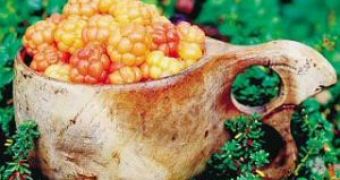The taiga or northern coniferous forest harbors about 50 plants producing berries, most of them edible. These fruits are vividly colored, have a strong aroma and are rich in vitamins and minerals. They also contain fibers that help stabilize the blood's sugar level and lower the cholesterol level. Their flavone and phenolic compounds are also beneficial for our health.
The taiga fruits can be served at breakfast with yogurt, granola, or oats porridge. When fresh, they can be used to make desserts and various pastry products. Mash or jelly made of these fruits form a wonderful topping for many dishes. Still, remember that not all the taiga fruits are edible (some are even poisonous) and in summer the taiga is full of swarms of mosquitoes and blood sucking midges. The most famous fruits of the northern forests are:
1.Bilberry or European blueberry (Vaccinium myrtillus) is highly employed in making sauces, puddings, jams and juices. It is also used in various pastry products, like the famous cranberry pie. When fresh, they are delicious with milk. Warning: they color in blue your tongue and lips.
2.Lingonberry, cowberry, or mountain cranberry (Vaccinium vitis-idaea) is used in making mash or jelly that can be eaten at dinner. From the vividly red fruits sauces, puddings, juices and pastry products are made. Because these fruits contain a lot of natural acids, they preserve very well, but this is also why they have a slightly acid taste that nobody appreciates.
3.The cloudberry plant (Rubus chamaemorus), also named bakeapple or salmonberry, is less than 30 cm (12 inch) tall and generates just one white flower, thus only one fruit. First the fruit is red and hard but while ripping it gets golden or amber colored and turns soft and juicy.
This Ice Age plant thrives in tundra, moors, bogs and marshlands. In southern Scandinavia, the fruit is ripe in August, but in the remote north at the beginning of the fall. The Laplanders and Inuit (Eskimos) have been collecting the cloudberries to be consumed in winter for centuries. The berry is juicy and rich in various vitamins, especially C and A (it contains 4 times more vitamin C than an orange), and, as it has a natural preservative, the marmalade can be kept in good condition in cool places for years.
In the northern lands plant food is scarce, and the meat and fish based diet of the northern people receives an important vitamin supplement through cloudberries. The Finns even honored the cloudberry by engraving it in their 2 Euro coin. The cloudberry has a refreshing and bittersweet flavor. These sweet fruits give a fine taste to desserts. In pastry and other shops around Europe and the US you can find cloudberry marmalades and jams, and even canned goods with cloudberry flavor. In the menu of the gala ball after the Nobel Prize Awardws (Sweden), cloudberry ice cream is included.
In luxury restaurants, warm cloudberry marmalade is a topping for vanilla ice cream. The marmalade also makes a filling for cakes and is a perfect supplement to the Swedish cheese cake or fried Camembert cheese. The golden cloudberry liquor is produced in Finland and in Canada, while in Sweden cloudberry wine is made. In Canada, cloudberries are also used to flavor a special beer. Freshly picked cloudberries are often eaten with sugar sprinkled on top and a large spoon of whipped cream.

 14 DAY TRIAL //
14 DAY TRIAL //